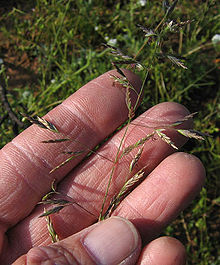| Poa secunda | |
|---|---|

| |
| Conservation status | |
 Secure (NatureServe) | |
| Scientific classification | |
| Kingdom: | Plantae |
| Clade: | Tracheophytes |
| Clade: | Angiosperms |
| Clade: | Monocots |
| Clade: | Commelinids |
| Order: | Poales |
| Family: | Poaceae |
| Subfamily: | Pooideae |
| Genus: | Poa |
| Species: | P. secunda |
| Binomial name | |
| Poa secunda J.Presl | |
| Synonyms | |
|
N O T E : This list has been aggregated from three sources, each having considerably differing lists of taxa
| |
Poa secunda (variously known by the common names of Sandberg bluegrass, alkali bluegrass, big bluegrass, Canby's bluegrass, Nevada bluegrass, one-sided bluegrass, Pacific bluegrass, pine bluegrass, slender bluegrass, wild bluegrass, and curly bluegrass) is a widespread species of perennial bunchgrass native to North and South America. It is highly resistant to drought conditions, and provides excellent fodder; and has also been used in controlling soil erosion, and as revegetator, often after forest fires. Cultivars include 'Canbar', 'Service', 'Sherman', and 'Supernova'. Historically, indigenous Americans, such as the Gosiute of Utah, have used P. secunda for food. It was originally described botanically in 1830 by Jan Svatopluk Presl, from a holotype collected from Chile by Thaddäus Haenke in 1790.
Native distribution
- In North America, Poa secunda is native to Canada (in Alberta; British Columbia; eastern Quebec; southern Saskatchewan; southern Yukon Territory; and, rarely, in Ontario), the U.S. (in southeastern Alaska; Arizona; California; Colorado; the Dakotas; Idaho; Isle Royale in Michigan; Montana; northwestern Nebraska; Nevada; New Mexico; Oregon; Utah; Washington; and Wyoming), and northwestern Mexico.
- In South America, it is native to Argentina (found in Chubut; Neuquén; and Santa Cruz), and central Chile.
References
- ^ NatureServe (2 June 2023). "Poa secunda". NatureServe Network Biodiversity Location Data accessed through NatureServe Explorer. Arlington, Virginia: NatureServe. Retrieved 9 June 2023.
- ^ Poa secunda was originally described and published in Reliquiae Haenkeanae 1(4–5): 271. 1830. "Name - Poa secunda J.Presl". Tropicos. Saint Louis, Missouri: Missouri Botanical Garden. Retrieved 15 December 2012.
- ^ "Profile for Poa secunda (Sandberg bluegrass)". PLANTS Database. USDA, NRCS. Retrieved 15 December 2012.
- ^ "Poa secunda". Germplasm Resources Information Network. Agricultural Research Service, United States Department of Agriculture. Retrieved 15 December 2012.
- "TPL, treatment of Poa secunda J.Presl". The Plant List; Version 1. (published on the internet). Royal Botanic Gardens, Kew and Missouri Botanical Garden. 2010. Retrieved 15 December 2012.
- Fact Sheet available in PDF and DOC form from USDA PLANTS Profile
- "Conservation Plant Characteristics for Poa secunda (Sandberg bluegrass)". PLANTS Database. USDA, NRCS. Retrieved 15 December 2012.
- Chamberlin, R. V. (1911). "The Ethno-Botany of the Gosiute Indians of Utah". Memoirs of the American Anthropological Association. 2 (5): 331–405 (p. 377).


External links
- Taxon report from Calflora
- Photo gallery from CalPhotos database
- Jepson Manual Treatment from the University of California
- Fire Effects Information Service information from the U.S. Forest Service
- Original description published in 1830, in Latin from the Biodiversity Heritage Library
| Taxon identifiers | |
|---|---|
| Poa secunda |
|
This Pooideae article is a stub. You can help Misplaced Pages by expanding it. |